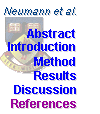| INABIS '98 Home Page |
|
Your Poster Session |
|
Related Symposia & Posters |
|
Plenary Sessions |
|
Exhibitors' Foyer |
|
Personal Itinerary |
|
New Search |

1 Kahneman, D. (1973). Attention and effort. Englewood Cliffs, NJ: Prentice Hall.
2 Ohman, A. (1979). The orienting response, attention, and learning: An information processing perspective. In H. D. Kimmel, E. H. van Olst, & J. F. Orlebeke (Eds.), The orienting reflex in humans (pp. 443-472). Hillsdale, NJ: Erlbaum.
3 Basil, M. D. (1994). Secondary reaction-time measures. In A. Lang (Ed.), Measuring psychological responses to media messages. LEA's communication series (pp. 85-98). Hillsdale, NJ: Lawrence Erlbaum Associates.
4 Siddle, D. A. T. & Spinks, J. A. (1992). Orienting, habituation, and the allocation of processing resources. In B. A. Campbell, H. Hayne, & R. Richardson (Eds.), Attention and information processing in infants and adults: Perspectives from human and animal research (227-262). Hillsdale NJ: Lawrence Erlbaum Associates.
5 Dawson, M. E., Filion, D. L., & Schell, A. M. (1989). Is elicitation of the autonomic orienting response associated with the allocation of processing resources? Psychophysiology, 26, 560-572.
6 Filion, D. L., Dawson, M. E., & Schell, A. M. (1994). Probing the orienting response with startle modification and secondary reaction time. Psychophysiology, 31, 68-78.
7 Filion, D. L., Dawson, M. E., Schell, A. M., & Hazlett, E. A. (1991). The relationship between skin conductance orienting and the allocation of processing resources. Psychophysiology, 28, 410-424.
8 Neumann, D. L., Lipp, O. V., & Siddle, D. A. T. (1998). The dissociation between skin conductance orienting and secondary task reaction time: Time course in a visual discrimination task. Australian Journal of Psychology, 50(1), 35-42.
9 Neumann, D. L. (1998). The Orienting Response and the Dissociation between Skin Conductance Responding and Secondary Task Reaction Time. Dissertation submitted for award of Doctor of Philosophy, The University of Queensland.
10 Siddle, D. A. T., Lipp, O. V., & Dall, P. J. (1996). The effect of task type and task requirements on the dissociation of skin conductance responses and secondary task probe reaction time. Psychophysiology, 33, 73-83.
11 Pashler, H. (1994a). Dual-task interference in simple tasks: Data and theory. Psychological Bulletin, 116, 220-244.
12 Moray, N. (1979). Mental workload: Its theory and measurement. New York: Plenum Press.
13
Tyler, S., Hertal, P., McCalum, M., & Ellis, H. (1979). Cognitive effort
and memory. Journal of Experimental Psychology: Learning, Memory, and
Cognition, 5, 607-617.
| Correspondence to: D.Neumann@ccrn.uwa.edu.au |